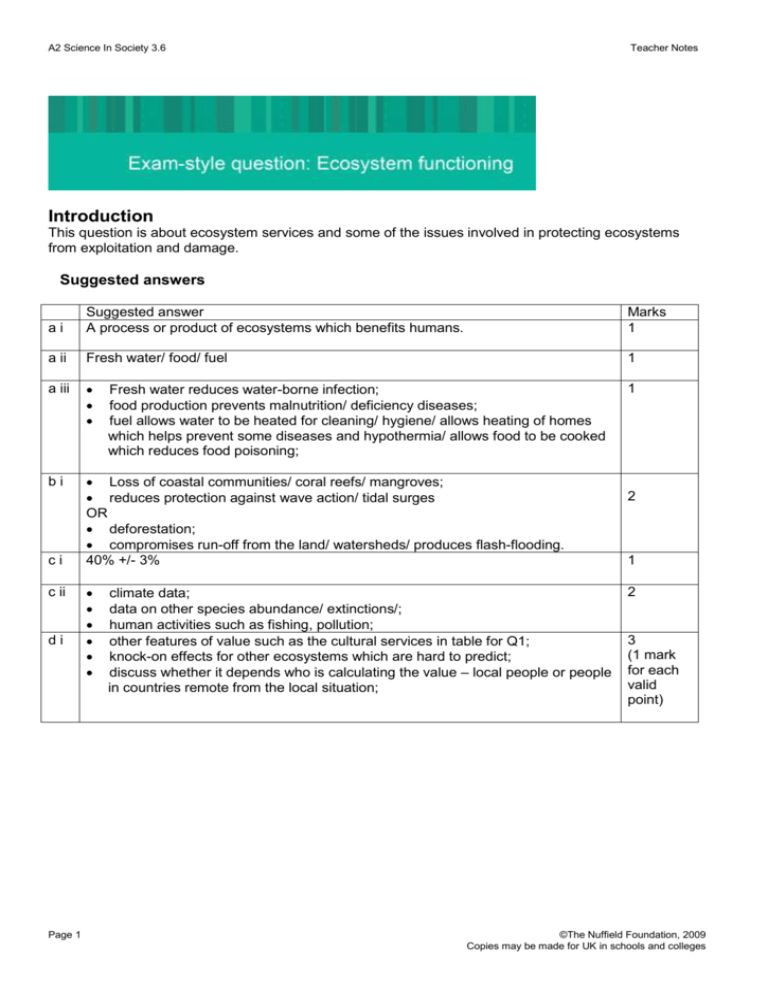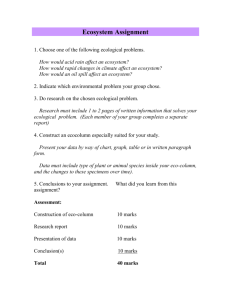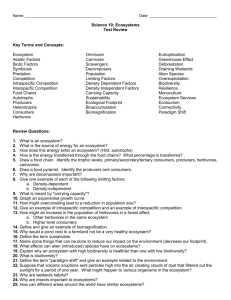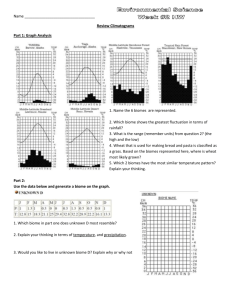Teacher notes and student sheets
advertisement

A2 Science In Society 3.6 Teacher Notes Introduction This question is about ecosystem services and some of the issues involved in protecting ecosystems from exploitation and damage. Suggested answers ai Suggested answer A process or product of ecosystems which benefits humans. Marks 1 a ii Fresh water/ food/ fuel 1 a iii 1 bi Loss of coastal communities/ coral reefs/ mangroves; reduces protection against wave action/ tidal surges OR deforestation; compromises run-off from the land/ watersheds/ produces flash-flooding. 40% +/- 3% ci c ii di Page 1 Fresh water reduces water-borne infection; food production prevents malnutrition/ deficiency diseases; fuel allows water to be heated for cleaning/ hygiene/ allows heating of homes which helps prevent some diseases and hypothermia/ allows food to be cooked which reduces food poisoning; climate data; data on other species abundance/ extinctions/; human activities such as fishing, pollution; other features of value such as the cultural services in table for Q1; knock-on effects for other ecosystems which are hard to predict; discuss whether it depends who is calculating the value – local people or people in countries remote from the local situation; 2 1 2 3 (1 mark for each valid point) ©The Nuffield Foundation, 2009 Copies may be made for UK in schools and colleges A2 Science In Society 3.6 d ii Local incentive schemes can work where there is an immediate impact of actions on people’s lifestyle or well-being; Local people should be given a say in, and take responsibility for the land that they live on; International concerns include the fact that whole ecosystems need to be protected to protect individual species within them, and these often straddle more than one country; not all countries can afford to carry out the necessary conservation work in their country; some countries have more than their fair share of conservation issues; biodiversity is a commodity for people wherever they live –, for example people all over the world benefit from the food and medicines which come from rainforests; Pay fishermen to fish (fish and other herbivores such as turtles) sustainably; to prevent removal of herbivores; that eat sea grass; so sea grass population is allowed to increase;/ pay land owners on the island; to keep tree/plant cover around rivers; to help prevent soil erosion; so coral is not killed by soil run-off; pay boat owners to keep distance from reef to prevent physical damage to coral; e Teacher Notes 3 (1 mark for each valid point) 4 any two ideas for 1 or 2 marks each total 17 marks June 2009 Page 2 ©The Nuffield Foundation, 2009 Copies may be made for UK in schools and colleges A2 Science In Society 3.6 Student sheets Question Ecosystems are important for human and non-human life. The table below lists some ecosystem services that have been categorised by the Millennium Ecosystem Assessment. Ecosystem goods and services GOODS (products from the ecosystem) Food, fibre, fuel, genetic resources, biochemicals, fresh water. CULTURAL SERVICES (non-material benefits of the ecosystem) REGULATING SERVICES (benefits from ecosystem processes) Spiritual and religious values, education, inspiration, recreation, aesthetic values. SUPPORTING SERVICES (services necessary for all other ecosystem services) Invasion resistance, herbivory, pollination, seed dispersal, climate regulation, disease regulation, natural hazard protection, erosion regulation, water purification. Primary production, provision of habitat, nutrient cycling, soil formation and retention, production of atmospheric oxygen, water cycling. (a) (i) Explain what an ecosystem service is. (1 mark) (ii) Using the table above, give an example of an ecosystem service that has an effect on human health. (1 mark) (iii) Explain how this service affects health. (1 mark) (b) Loss of biodiversity disrupts the ecosystem functions that give protection against natural disasters such as flooding, mud slides, and tidal surges on coasts. Choose one such natural disaster and explain how loss of biodiversity influences the severity of this type of natural disaster. (2 marks) Page 1 ©The Nuffield Foundation, 2009 Copies may be made for UK in schools and colleges A2 Science In Society 3.6 Student sheets percentage of live coral cover Figure 1 Percentage of live coral cover across the Caribbean basin from 1997 to 2002 (c) The graph above shows the change in live coral cover across the Caribbean basin (i) What is the % loss of coral cover between 1977 and 2002? (1 mark) (ii) Suggest two types of additional information which could help to explain the fall in coral cover over this time. (2 marks) (d) (i) A financial value can be calculated for an ecosystem, relating to the benefits that it offers to humans. Discuss whether this financial value should be the main criterion for allocating funds to conserve a particular ecosystem. (3 marks) (ii) Explain why monitoring and protecting biodiversity should be funded both locally and internationally. (3 marks) (e) Factors which increase the decline of coral include: swamping by sea-grass when the natural herbivores that eat the sea grass decline; physical damage from boats; silting up when soil is present in water run-off from the land. Suggest two measures that might be included in an incentive scheme to prevent behaviours that result in damage to coral in the Caribbean basin. Explain how each could work. (4 marks) (total 18 marks) Page 2 ©The Nuffield Foundation, 2009 Copies may be made for UK in schools and colleges







